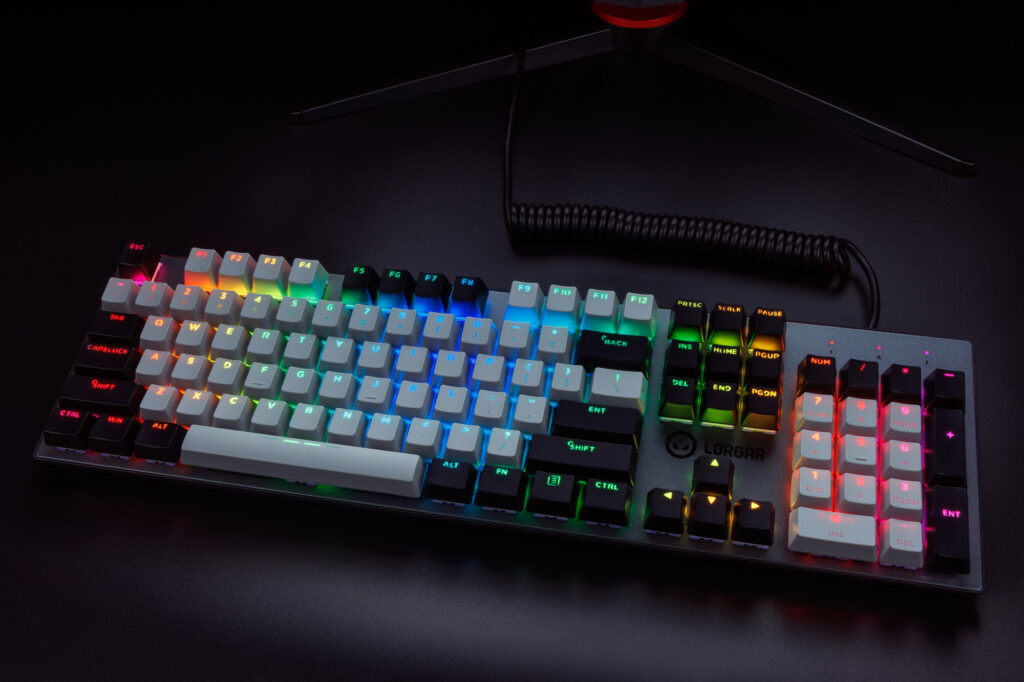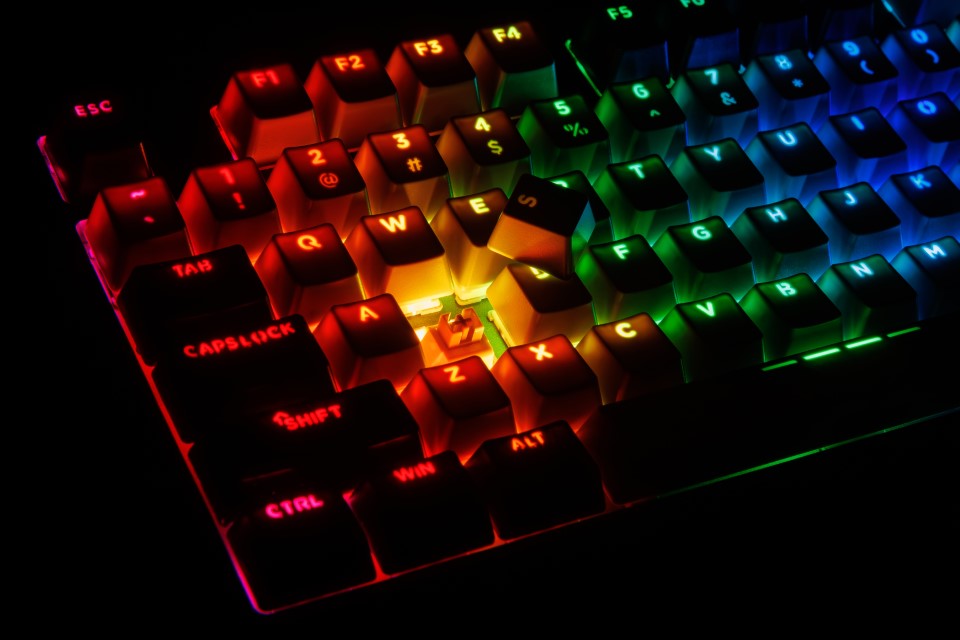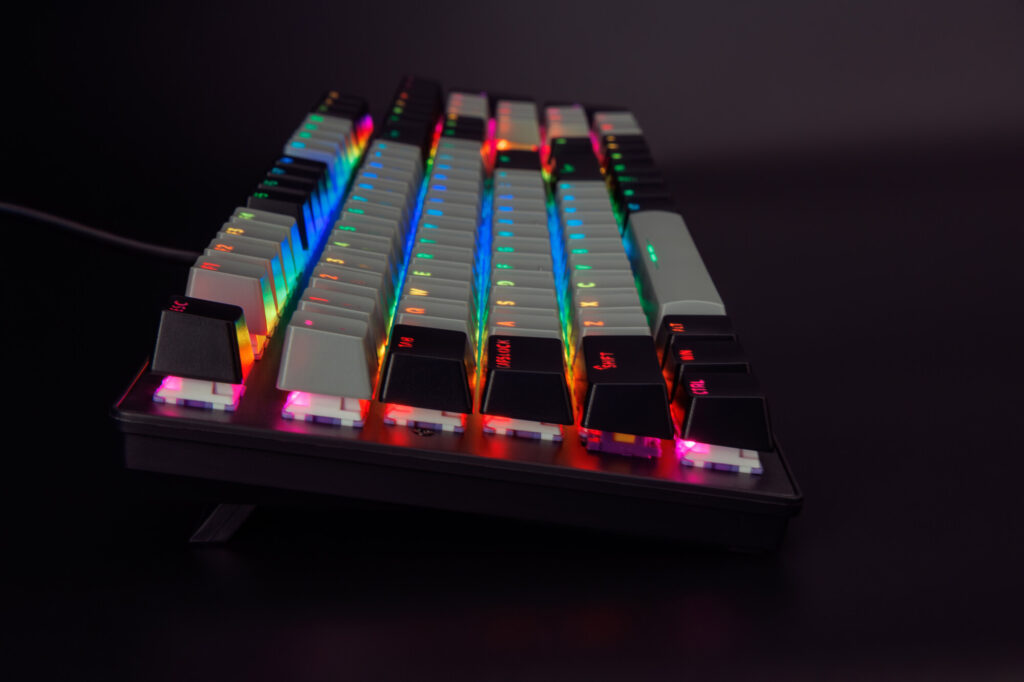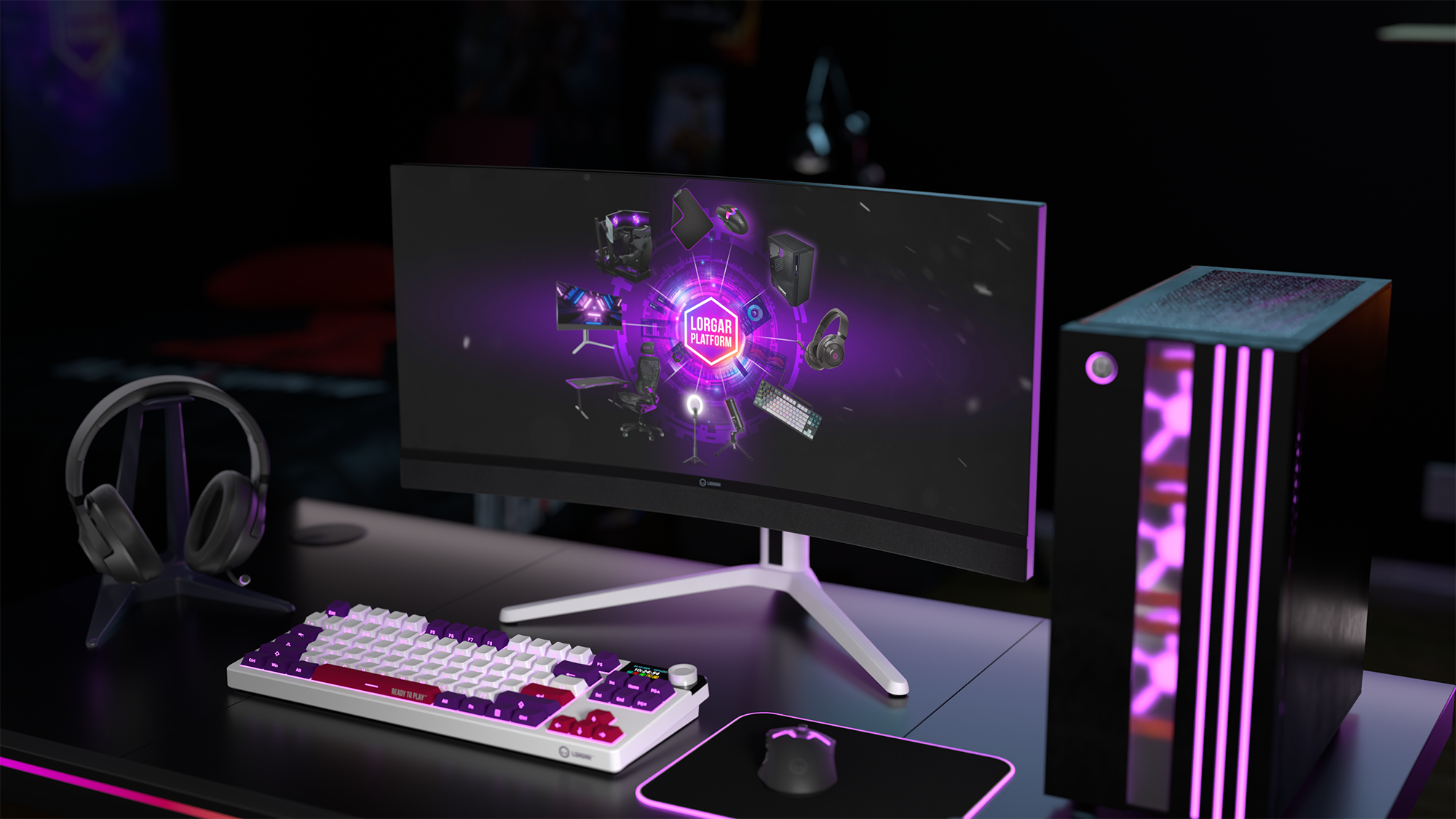No two keyboards are created equal, and obviously their size is the easiest factor to separate them. The market proposes everything from full-size layouts to the compact 60% designs (and even smaller). This guide will help you to understand keyboard sizes, starting from the easy question of how many keys on a full size keyboard.
But first, you need to understand the dictionary. One way to identify keyboard size is by saying percentage of full-size layout: like “96%” or “60%”, where full-size is “100%”. This naming approach fits any type, but is not the most popular way to name some sizes. Same can be said about the number of keys used to identify: i.e. “104-key” or “87-key” – can be applied to any keyboard but not used much for some layouts. The word “Compact” is used liberally for various 60-75% keyboards, while “TKL”, “Planck” and “1800” describe very specific types. So, overall, don’t be surprised to see multiple possible descriptions of the same keyboard.

Full-Size Keyboard: The Classic
The full-size layout is the standard Image most people associate with the keyboard in their minds. Known also as a 100% keyboard, this is rightly the flagship of the keyboard fleet, familiar since the 1980s. It typically features around 104 keys, including a complete QWERTY layout with numeric row above and several modifier keys (Shift, Ctrl, Alt), row of function keys, navigation cluster with 4 arrow keys below it, and a numeric keypad. By the way,the aforementioned “QWERTY” is a usual name for the most popular English language layout, which has been here since the advent of typewriters. This specific, non-alphabetic, order of letter keys was scientifically chosen for the best typing results.
Full-size keyboards are the most universal style, which makes them suitable for almost any type of work. Separate numpad come in handy for entering data, or if you are working with numbers a lot. And every other key is in the same familiar place where it belongs for ages.
The downside of using a full-size keyboard is its footprint. It feels like a lot of desk real estate is lost, but that’s not the biggest drawback. Long keyboard means that your mouse is quite far away to the right – further than doctors recommend. In extreme cases, it can become not only an ergonomic issue, but a health consideration too, due to the shoulder strain.
Nonetheless, full-size keyboards are liked because they defy the learning curve. This makes them a great option for users who desire to access each individual key without relying on function layers or key combinations. Obviously, if you feel that the numeric keypad is seldom used and you better exchange it for some desk space, a more compact keyboard could be just what you’re looking for.
96% Keyboards: Smaller without Sacrifice
The 96% format is now rediscovered by those who need a numpad, but are looking for a slightly more compact layout: it removed a separate section with six navigation buttons above the arrows, leaving four of them in the top (function) row after F12.
The second, or rather the first, name of this format is “1800”, in honor of the keyboard which has been produced in this layout since 1989! It appeared as a solution for use in a standard 19″ server rack and other places where a smaller width is important.
Another name for the format is “100-key”, because that’s how many keys are usually on such keyboards, compared to 104-106 in full-size and 87 in TKL. At the same time, this format is similar in width to TKL, but it is suitable for those who prefer to use a numpad. It should be understood that like the TKL, the 96% is not a “compact” keyboard, rather it is simply “more compact”.

TKL Keyboards: Everything but the Numpad
TKL keyboard size (which means “Tenkeyless”) is what has made this product so popular over time. As it says, these keyboards eliminate the numeric keypad (or ‘ten keys’) that is present on standard 104-key models. This makes the keyboard shorter while retaining all the other keys found on a standard layout.
A TKL layout normally has around 87 to 88 keys, based on the manufacturer, which brings yet another name – “87-key”. All existing keys are exactly where you typically expect to find them: alphanumeric keys, function keys, navigation cluster. The only thing missing is the numeric keypad.
The biggest benefit is its size savings when compared to full-size keyboards. Third colloquial name: “80%”, says it all about the freed-up desk space. That will be helpful for those with smaller desks or just desiring something more minimal. The reduced footprint of TKL keyboards as well means that they are more portable, which has seen them become very popular amongst professionals who have to move their setup around a lot. Tenkeyless keyboards are also generally better for your health, too! The absence of the numpad allows users to keep the keyboard closer to the mouse thus reducing shoulder strain during prolonged use.
Of course, there are at least two categories of users, who will find TKL keyboards unacceptable. First, there are those who work a lot with numerical data and are accustomed to do it on a numpad. It is possible to enter numbers using the number row but it is slower and less natural. Second, there are people who like to fly planes in GTA 5. It may sound humorous, but that’s probably the most popular reason to ask for a numpad for gaming. Let’s see what will happen in GTA 6 with plane controls…
75% Keyboards: Compact, Yet Powerful
Now we’re coming to the realm of “compact” keyboards and the biggest of them is the “75%” layout for those who want to go smaller than TKL but aren’t ready to give up their function keys and arrow keys. Typically these keyboards have around 83 keys (which brings the second name, “83-key”). This means a majority of the function set that full-size boards offer is preserved but in a much smaller footprint.
The 75% layout gets its compact build by condensing the TKL keyboard. The function row will typically (but not on all keyboards) be moved closer to the number row, eliminating the horizontal spacer between them. Navigation keys are placed into a space on the right side of your keyboard in an order never seen before. Overall, the design appears to be far more space-efficient and still retains dedicated arrow keys as well as function keys. 75% keyboard seems to be a perfect blend of functionality and compactness, as they offer almost all the keys of a TKL keyboard but in a size that’s closer to a 60% layout. By the way, the typical laptop keyboard fits closely into 75% realm, although it seems that each manufacturer there has their own ideas about the optimal number of keys, while true 75% keyboards for desktop use are more or less standardized.
Yet the 75% keyboard layout can be a bit crammed, at first. The unusual placement of some keys and unusual spaces between others may require re-training. On top of that, its non-standard layout might also make it difficult to find replacement keycaps if you are looking for customization. Despite these potential downsides, 75% keyboards have built up quite a following among the keyboard enthusiast community.
65% Keyboards: No Function Keys, Still Fun
Heading further towards the compact end of that spectrum, here is the “65%” layout, also known as “68-key” because they usually also have about 68 keys. The 65% layout is a more compact version of the 75% layout. It retains the alphanumeric keys, arrow keys and a part of the navigation cluster (Page Up, Page Down, Home and End). But the function keys F1-F12 are reached via a function layer, which is toggled by pressing some designated key.
The primary selling point for 65% keyboards is quite simply how small it can get. They use up much less space compared to bigger layouts, even 75%, which is perfect for those tight on desk room or anyone else who wants to achieve a minimalist setup. The fact that they are 1 row shorter vertically than 75% helps a lot in this visual pursuit.
But the 65% layout does bring more compromises than 75% too, with that lack of F-keys. Absence of the physical row of function keys will annoy those who frequently use them. Though you can get to these keys in a function layer, that extra step will make workflows with them slower. Also, similar to 75% keyboards the 65% layouts frequently have somewhat non-standard sizes for certain keys which can restrict your options when it comes to custom keycaps.
60% Keyboards – The Ultimate in Reasonable Compactness
60% layout is the extreme end of a compact keyboard for a regular user. These keyboards usually only have 61 keys, as they eliminate function row, navigation cluster and arrow keys, too. Nothing left but the bare essentials: alphanumerics and modifiers.
Minimalists give rave feedback about 60% keyboards because of their small size. But it’s not only about aesthetics and clutter-free workspace. Small keyboard allows more room for mouse movement; something FPS gamers with low sensitivity settings appreciate very much (and they usually don’t need a lot of keys for their primary use case, anyway).
Despite 60% is so tidily petite layout, it still retains full functionality, just not on the primary layer of key mappings. Hold down a special key (usually where Caps Lock sits on a 100% keyboard) and press another key to another function. For instance, while holding down that function key WASD can act as the arrow keys. This can sound acceptable for some users, but those dealing with a lot of text edits may strongly disagree and thus prefer at least 65% keyboard, where the arrow keys are still present physically.
This method of layering makes it possible for a 60% layout to fit an entire range of features into a device much smaller than a full-size keyboard. However, it comes with a learning curve. Users with bigger keyboards keys may be reaching for buttons that are no longer there. It is also a change in muscle memory from pressing separate keys to pressing key combinations.
Obviously, a 60% keyboard is very portable (both small and lightweight), especially in a wireless model. Sometimes, even a travel case is provided with the device for those users, who would like to keep their beloved mechanical keyboard with them on-the-go.
But the 60% keyboard foray into extreme minimalism isn’t meant to be perfect either. Those who truly rely on function keys, the arrow cluster or navigation controls in their daily routine will likely get aggravated with the constant use of function layers. And for some specialized software, particularly in fields like video editing or 3D modeling where keyboard shortcuts are crucial, this layout may create a needlessly difficult workflow.
Exotic Layouts: 40% and beyond
The market of keyboards can be deeper than the traditional layouts, though one has to be a truly brave typist to explore its depths. This really goes to the limit of minimalism, ergonomics and type habit adaptations with very exotic design.
40% Keyboard represents extreme compactness. Most of these ultra minimal designs will only have somewhere between 40 and 50 keys, stripping away everything but the bare essentials. Users need to press multiple keys in combination to access numbers, symbols, and navigation functions. While this can seem daunting at first, enthusiasts argue that once mastered, 40% allows for extremely efficient typing with minimal hand movement. Also, being the smallest more or less fully functional keyboard, 40% becomes a popular choice for DIYers who develop their own printed board, pick the switches and keycaps, and even 3D-print a case to make the keyboard truly custom.
An ortholinear keyboard is one of the other uncommon options. With keys arranged in perfect grids vertically and horizontally, it is a radical departure from the staggered key layout that harkens back to typewriters. Advocates of this design explain that there is no real reason to keep the staggered keys for a computer keyboard and they argue that it shortens the distance your fingers have to travel, and keeps your hands at a more natural angle. The learning curve can be steep, as grid-like placement of keys requires retraining muscle memory. By the way, the ortholinear layout and 40% size combined in one device is known as the “Planck” keyboard.
This is another break from traditional design – split keyboards. As the name implies, are two separate halves that can be placed independently of each other. Better ergonomic design means a more natural width of shoulders and angle at the wrist, reducing risk of RSI (repetitive strain injury). Split keyboards can appear in any size from 100% behemoths to compact 40%.
Most of these exotic layouts are essentially catered towards keyboard enthusiasts and whoever wants to improve their typing experience or whatever ergonomic issue. However, to the casual user that is extreme and while it remains overboard for most people in real-world use cases, such products are on the leading edge of keyboard design and offer performance above-and-beyond any other product. While not for everyone, these unique layouts can provide the most customised and potentially ergonomic typing experience available to those who are willing to invest time in learning a new layout.
Different Size Keyboards for the Different Users

So, how to choose the right keyboard size? The sad truth of keyboard sizes is that there is no silver bullet, no perfect solution. In fact, it is an extremely personal affair, which depends on several factors. Think about how much desk space you have, as well as the way you type and what your individualized needs are. How often do you use the numpad? How would you feel about learning new key combinations to do usual things? What level of portability do you expect, if any?
As a result, most keyboard enthusiasts own multiple keyboards of different sizes for different purposes. There are tons of options available to cater your needs, so you should probably just be trying things out and watching this is most beneficial for yourself.
The ultimate goal is to have a keyboard that feels comfortable, enhances your productivity, and complements the look-and-feel of your desk setup. Will it be full-size or 60% or anything in between, the right choice will make your daily computing experience more enjoyable and efficient.





